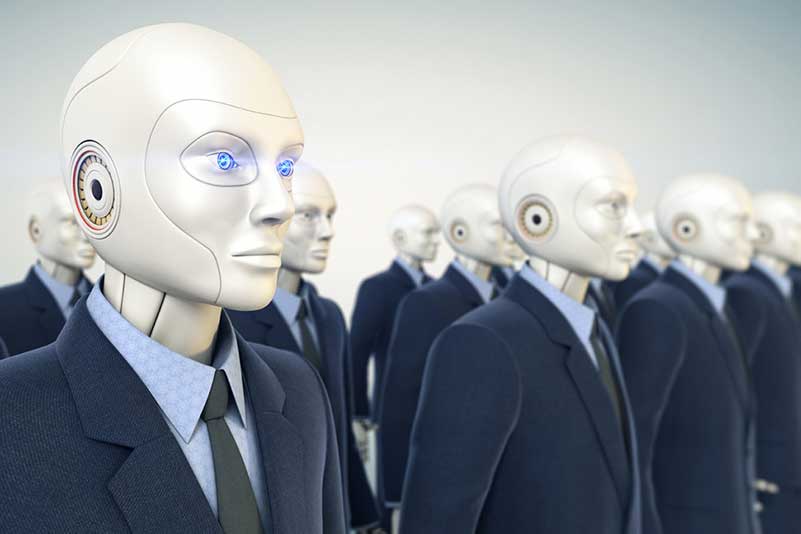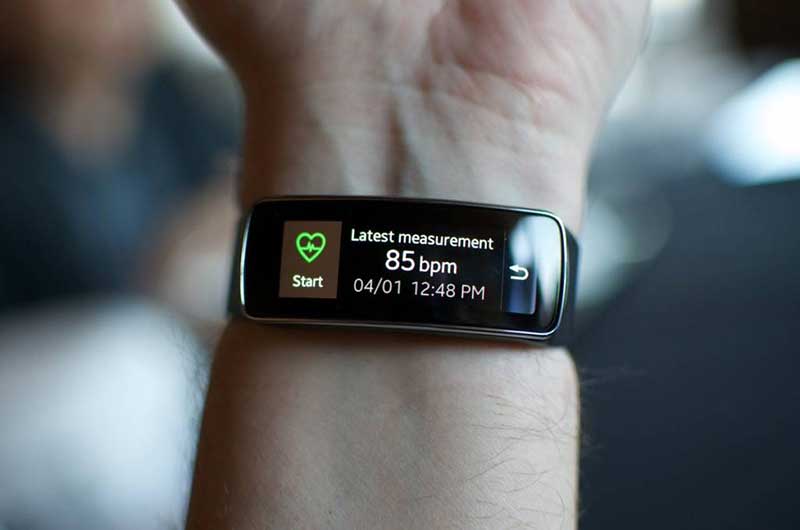- Decentralised Autonomous Organisations (DAOs): hierarchy goes out the door
- New leadership skills create staying power for the 21st century organisation
- The workforce of the future is microchipped
- Increasing collaboration and creativity with hot-desking
- Exploiting emerging tech is no longer optional
- Health and fitness tracking devices as a condition for employment
- Maturing artificial intelligence forces companies to restructure
In order to remain competitive, established organisations need a serious overhaul, and we’re not only talking about getting on board with the latest technology. In the company of the future, rigid hierarchies are replaced by non-hierarchical structures such as Decentralised Autonomous Organisations (DAOs). Many organisations will start kitting their employees out with high-tech wearables and some will even have their staff microchipped. Hot-desking enables collaborative sharing spaces, taking employee productivity and involvement to the next level. Will embracing these new trends give the company of the future a good chance at survival and staying power for the 21st century?
Decentralised Autonomous Organisations (DAOs): hierarchy goes out the door
In companies of the future, traditional hierarchy is history. In fact, there might not be any kind of hierarchy left whatsoever – no bosses and no management teams. Based on Blockchain technology, DAOs eliminate the need for CEOs and management staff and, instead, make use of shareholders who can vote on issues regarding the organisation. Initially designed to serve as a venture capital fund, DAO managed to earn the largest crowdfund in history, raking in a whopping $130 billion. What distinguishes DAOs from similar setups is that they don’t require intermediaries. Project proposals are submitted directly to the DAO in the form of smart contracts. Investors or shareholders can then either approve or dismiss those projects by voting. While the elimination of hierarchical structures as a result of DAOs may seem like a far-into-the-future scenario, these changes already happening.

New leadership skills create staying power for the 21st century organisation
In the past, CEOs and managers were mostly focused on instructing their employees and making sure they performed their tasks. Not much energy was invested in actually providing guidance and inspiration or encouraging collaboration. In most successful startups – and even in larger, evolving companies and organisations – greater levels of decision making and delegation are visible at every level. 21st century leaders focus on communicating the company vision and finding ways to develop and guide their staff and coworkers. They pass increasing amounts of responsibility to junior staff.
If companies want to have a flatter structure and develop leaders from within their organisation, they will need to spend a significant amount of time teaching team members how to lead. Creating leaders who can communicate, develop and execute a vision doesn’t happen by merely hiring a keynote speaker to do a leadership presentation or organising three-day leadership workshops. Empowering leaders should come from the organisational structure and culture, encouraging people to continuously learn, take charge and yes, make mistakes. The upsides of designing systems and cultures that develop new, empowered leaders are virtually limitless. More people feeling inspired and connected to their work. Senior leaders spending less time on management and more time on visionary leadership. More staff members leading, at a lower payroll cost. The list goes on.

The workforce of the future is microchipped
Most companies find technological changes desirable. They bring efficiency, innovation and overall productivity. Incorporating such changes is essential for business success, but some take this a significant and controversial step further. For instance, Swedish firm Epicenter has implanted radio-frequency identification (RFID) chips into their employees’ hands. With these chips, employees can operate the vending machine, make photocopies or open doors. According to futuristic finance leader Paula Kensington, microchipping employees offers many benefits. “Flexibility is the new currency in workplaces. If you become a chip-wearing person, you’re going to be allowed greater flexibility, because your employer can tell what you’re doing.” Although ‘innovation’ at this level is (still) far from common practice in most companies, the message it sends is clear — the workplace is changing, and to stay on top, businesses need to adapt to and embrace these ongoing trends.
Increasing collaboration and creativity with hot-desking
The road to creative business solutions demands collaboration, which is not easy if your employee works in his own office, by himself, eight hours a day. To build and enhance strong relationships among coworkers – and to reduce space as well as costs – companies increasingly turn to hot-desking; replacing permanent desks with desk sharing. This type of work environment can be found at Deloitte’s smartest building in the world, the Edge. To prevent disorganisation that may occur when coworkers are looking for an available desk, Deloitte’s employees have an app which tells them which spots are open. Companies like Citigroup and American Express also recently jumped on the hot-desking bandwagon and pharmaceuticals giant GlaxoSmithKline manages to save $10 million per year using hot desks instead of conventional offices.
Some companies, like Paramount’s office building in Australia, prefer partly incorporating hot-desking into their traditional office settings, enabling those who are not yet ready to share a desk to enjoy the privacy of their own office a while longer.
Whether you’re sharing or hogging a desk, the workplace of the future will revolve around inspiring employee productivity and success. Businessman and author William Clement Stone once said, ‘’you are a product of your environment. So choose the environment that will best develop you toward your objective. Are the things around you helping you toward success – or are they holding you back?”
https://www.youtube.com/watch?v=ezknaQ0LMoA
Exploiting emerging tech is no longer optional
Robotics and automation of the workforce are among the major driving forces disrupting outdated business strategies. In fact, exploiting the emerging tech is no longer an option that companies ‘might take into consideration’. It’s imperative. Unavoidable. Of course, this doesn’t mean that human workers will completely vanish. The changes will be most visible in task redistribution. Robots will be assigned low-skilled tasks, leaving the higher-skilled to do the managing. Amazon’s fulfilment centre in DuPont, Washington, is an example of how automation boosts productivity. As boxes travel on a conveyor belt, they are scanned and photographed. Then, image-recognition algorithms sort the parcels, based on variables such as size and weight. And what used to take an hour can now be accomplished in half the time or even faster.
Thomas W. Malone, a professor at MIT Sloan School of Management and co-director of MIT’s Inventing the Organisations of the 21st Century initiative, makes an excellent point saying that this is actually “the opportunity for humans to work with machines.” In the not so distant future, human workers will not only supervise robots, they will work alongside them, representing the business model of the future for many industries.

Health and fitness tracking devices as a condition for employment
Wearables such as fashionable smartwatches and fitness trackers have become the everyday accessories of this generation and increasingly, their industrial counterparts show immense potential in making workplaces more efficient, smarter and safer. PwC (PricewaterhouseCoopers) reports that “by 2020, over 75 million wearable devices will be used at the workplace,” while Gartner Research estimates that “by 2018, two million employees will be required to wear health and fitness tracking devices as a condition for employment.” Employees are increasingly wearing motion monitors, brain activity sensors and posture coaches and they actually show an increase in productivity and even job satisfaction, according to a recent study by Rackspace, leader in independent evaluation for hosted private cloud services. Technical staff can use Google Glass to control machines or production remotely. For instance, aerospace giant Boeing uses Google Glass to display technical diagrams to employees working on assembling electric wire harnesses for aircraft. Whether it’s a device surgeons use to perform complex procedures or construction workers wearing a ‘smart helmet’ on the building site, wearables are set to infiltrate every part of working life with compelling benefits for employees and employers alike.

Maturing artificial intelligence forces companies to restructure
According to Deloitte’s 2017 Human Capital Trends Report, maturing artificial Intelligence (AI) is already forcing companies worldwide to restructure and transform their HR departments. This affects their hiring practices and necessitates the design of new training models. Josh Bersin, principal and founder of Bersin by Deloitte, leading research and advisory services firm in strategic HR solutions, assures us however that AI won’t ‘erase the human workforce’. “What we concluded is that what AI is definitely doing is not eliminating jobs, it is eliminating tasks of jobs, and creating new jobs, and the new jobs that are being created are more human jobs.” With ‘more human jobs’, Bersin means those jobs that require traits like communication, empathy and problem solving. He adds, “…individuals that have very task-oriented jobs will have to be retrained, or they’re going to have to move into new roles.”
Share via:


